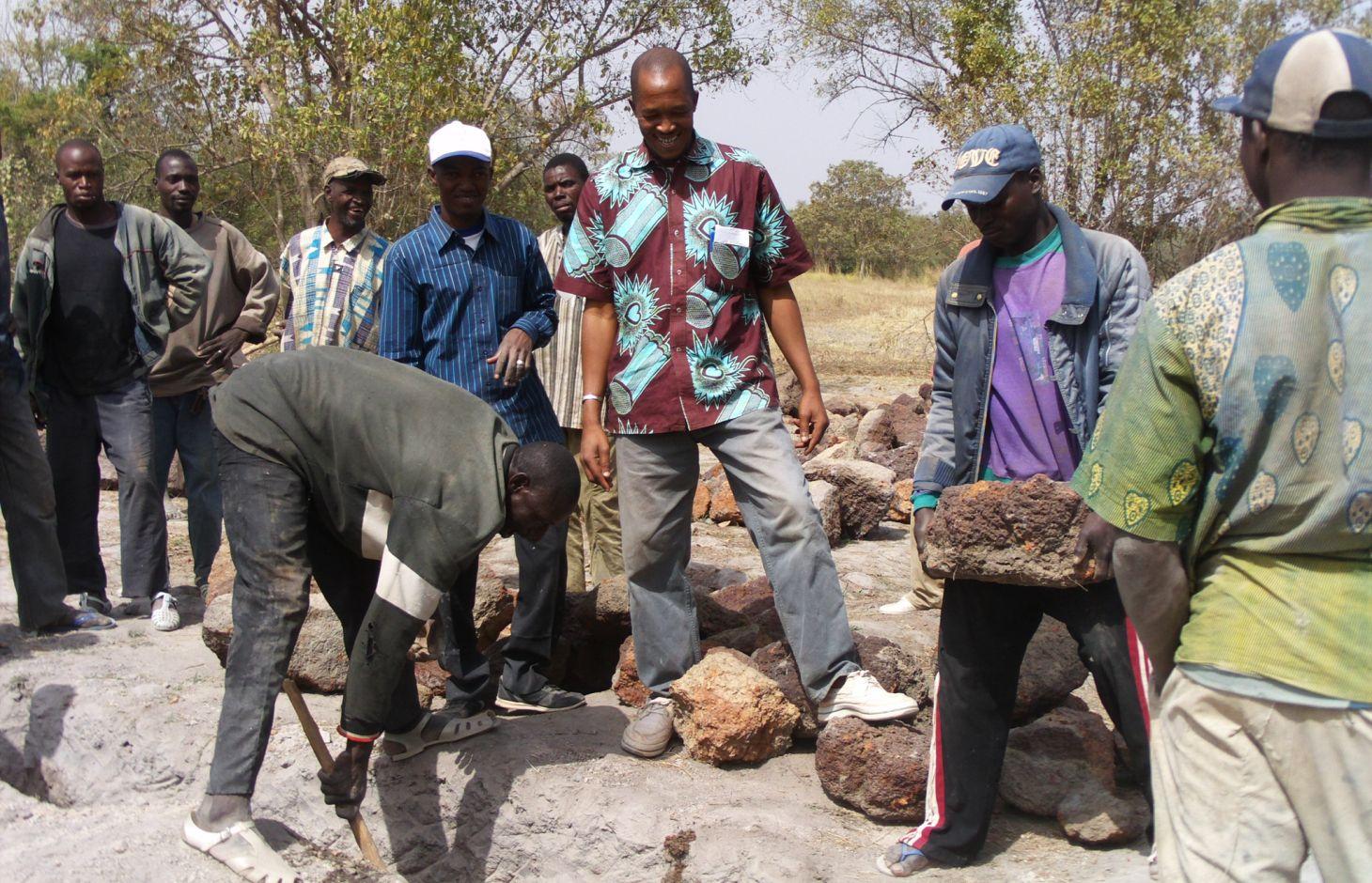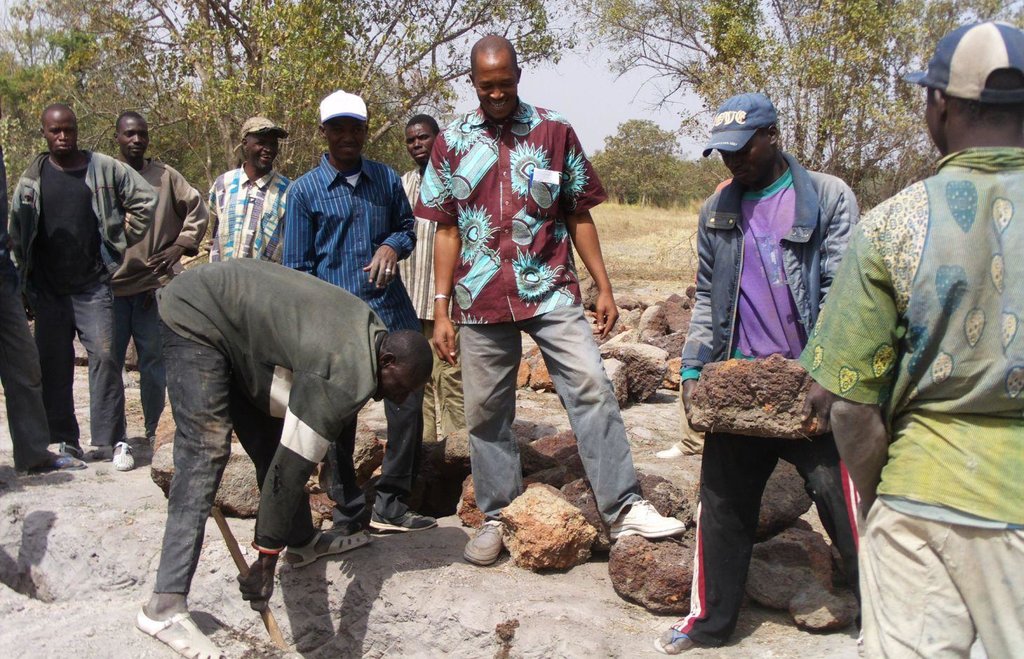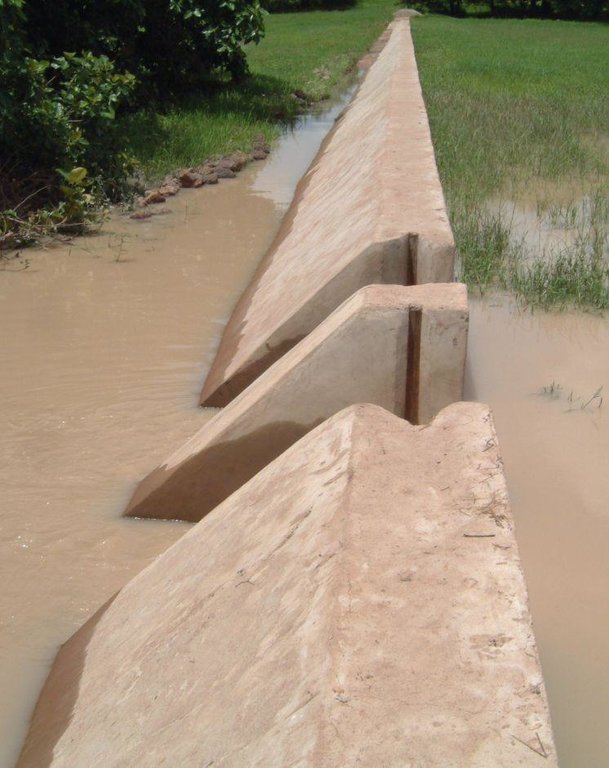Dams with water-spreading weirs [马里]
- 创建:
- 更新:
- 编制者: Dieter Nill
- 编辑者: –
- 审查者: Deborah Niggli, Alexandra Gavilano
Barrages avec seuils d’épandage déversant (French)
technologies_1633 - 马里
查看章节
全部展开 全部收起1. 一般信息
1.2 参与该技术评估和文件编制的资源人员和机构的联系方式
SLM专业人员:
Dembele Celestin
HELVETAS Swiss Intercooperation
马里
SLM专业人员:
Doumbia Moussa
ADEPE MALI
马里
有助于对技术进行记录/评估的项目名称(如相关)
Manual of Good Practices in Small Scale Irrigation in the Sahel (GIZ )有助于对技术进行记录/评估的机构名称(如相关)
Deutsche Gesellschaft für Internationale Zusammenarbeit (GIZ) GmbH (GIZ) - 德国1.3 关于使用通过WOCAT记录的数据的条件
编制者和关键资源人员接受有关使用通过WOCAT记录数据的条件。:
是
1.4 所述技术的可持续性声明
这里所描述的技术在土地退化方面是否存在问题,导致无法被认为是一种可持续的土地管理技术?:
否
2. SLM技术的说明
2.1 技术简介
技术定义:
The role of small dams with weirs is to raise the water table, expand rice growing areas and extend the availability of water in lowland areas to complete the agricultural cycle of lowland areas (rice and vegetable growing).
2.2 技术的详细说明
说明:
Small dams are installed on minor river beds and are connected up to the riverbanks. Their above-ground dimensions are small, but trench depths can be quite substantial in the case of a subterranean dam two to three metres deep. Plastic sheeting is placed in the trench to stop the water flowing underground.
Weirs are low-level structures built in flat valleys as extensions of small dams. Dam walls are low in height, standing from 0.1 m to 1 m above ground level.
The underground section of the dam retains upstream waters. As a result, the ground absorbs water and moisture throughout the entire area affected by the dam. The above-ground section (a watertight wall equipped with outflow gates) discharges the upstream water. It has a weir running along the marigot. Downstream, a stilling basin is installed to prevent erosion caused by the falling water. Using the weir and outflow gates, the water level can be adjusted to the requirements of each rice growing stage. The water retained by a dam equipped with a weir cannot be conserved for long periods. The structure’s main role is to provide water to meet the needs of the rainy-season crops. Even though the trenches are deep and the plastic sheeting prevents underground water dissipation, weirs can help to ensure ground waters are well recharged. This is why farmers should wait before digging wells to extract water for vegetable growing.
Local people formulate the requirement and negotiate with the commune on the investment programme, identify the rules of access and set up the farming cooperatives and management bodies, provide materials and unskilled labour during construction, and undertake small-scale maintenance work. The commune plans investments and assumes overall control of the construction work, delegates management to users, validates the farming rules and oversees their correct application, and undertakes major repairs. Consultancies carry out the socio-economic, environmental and technical studies (scheme design, plans, models), draw up the invitation to tender document and support the tender selection process, and monitor and inspect works. Technical services oversee the application of technical and environmental standards, and participate in ensuring sound financial practices (collection, financial control, public service concessions). Contractors carry out the construction work. The project team provides training (planning, social engineering, studies involving farmers, etc.) and advisory support (organisation of users, formulation and validation of rules, area development plan, plan to develop and exploit value chains).
The scheme can remain functional for up to 20 years provided it is rigorously maintained. The users are divided up into management and maintenance teams and their respective responsibilities are clearly defined.
More than 120 schemes with an average area of 20 hectares were built between 1998 and 2012. These schemes cover an area of more than 2,400 hectares and directly benefit over 15,000 families. The low cost combined with quick returns makes this type of intervention suitable for poor communities and local authorities. These structures can also be installed in dry areas. In these areas, it is essential from the outset that anti-erosion measures are put in place to manage the risk of sand encroachment.
2.3 技术照片
2.5 已应用该技术的、本评估所涵盖的国家/地区/地点
国家:
马里
区域/州/省:
Mali
有关地点的进一步说明:
Sikasso region (Yorosso, Koutiala, Sikasso, Kadiolo, Kolondiéba, Bougouni, Yanfolila), Ségou region
具体说明该技术的分布:
- 均匀地分布在一个区域
如果不知道精确的区域,请注明大致覆盖的区域:
- 10-100 平方千米
注释:
More than 120 schemes with an average area of 20 hectares were built between 1998 and 2012. These schemes cover an area of more than 2,400 hectares and directly benefit over 15,000 families.
2.6 实施日期
如果不知道确切的年份,请说明大概的日期:
- 10-50年前
2.7 技术介绍
详细说明该技术是如何引入的:
- 通过项目/外部干预
注释(项目类型等):
Since 1998, through Helvetas Swiss Intercooperation
3. SLM技术的分类
3.1 该技术的主要目的
- 改良生产
3.2 应用该技术的当前土地利用类型
同一土地单元内混合使用的土地::
是
具体说明混合土地使用(作物/放牧/树木):
- 农牧业(包括农牧结合)

农田
- 一年一作
每年的生长季节数:
- 1
具体说明:
Longest growing period in days: 120, Longest growing period from month to month: August-November

牧场

水道、水体、湿地
- 池塘、大坝
注释:
Major land use problems (compiler’s opinion): water loss, aridification, low water table
Livestock density: 1-10 LU /km2
3.4 供水
该技术所应用土地的供水:
- 混合雨水灌溉
3.5 该技术所属的SLM组
- 灌溉管理(包括供水、排水)
- 引水和排水
- 地表水管理(泉、河、湖、海)
3.6 包含该技术的可持续土地管理措施

结构措施
- S5:大坝、集水斗、水池
3.7 该技术强调的主要土地退化类型

水质恶化
- Ha:干旱化
- Hs:地表水良变化
- Hg:地下水/含水层水位的变化
注释:
Main causes of degradation: over abstraction / excessive withdrawal of water (for irrigation, industry, etc.)
3.8 防止、减少或恢复土地退化
具体数量名该技术与土地退化有关的目标:
- 防止土地退化
- 减少土地退化
4. 技术规范、实施活动、投入和成本
4.1 该技术的技术图纸
技术规范(与技术图纸相关):
Technical knowledge required for field staff / advisors: high
Technical knowledge required for land users: low
Main technical functions: increase of infiltration, increase / maintain water stored in soil, increase of groundwater level / recharge of groundwater, water harvesting / increase water supply, water spreading
Dam/ pan/ pond
Height of bunds/banks/others (m): 1
4.2 有关投入和成本计算的一般信息
其它/国家货币(具体说明):
CFA Franc
如相关,注明美元与当地货币的汇率(例如1美元=79.9巴西雷亚尔):1美元=:
517.0
4.3 技术建立活动
| 活动 | 时间(季度) | |
|---|---|---|
| 1. | It is in community-led planning initiatives that the request for a lowland development scheme takes shape. | |
| 2. | The request is analysed (in consultation with the client community) to ascertain the socio-economic gains for the beneficiaries, the strengths and development potential of the area, and the motivation levels of the actors involved. | |
| 3. | The results are summarised in a report on the ideal development scenarios put forward by local people. Results are fed back to the community at a public meeting | |
| 4. | the findings of the technical diagnostic exercise are developed as a 3D model | |
| 5. | The consultant then moves on to performing economic and financial analyses, which will con- firm the cost effectiveness of the scheme | |
| 6. | A funding agreement is signed by the commune, farmers and project team |
4.4 技术建立所需要的费用和投入
| 对投入进行具体说明 | 单位 | 数量 | 单位成本 | 每项投入的总成本 | 土地使用者承担的成本% | |
|---|---|---|---|---|---|---|
| 其它 | total construction | 1.0 | 48703.0 | 48703.0 | ||
| 技术建立所需总成本 | 48703.0 | |||||
| 技术建立总成本,美元 | 94.2 | |||||
4.5 维护/经常性活动
| 活动 | 时间/频率 | |
|---|---|---|
| 1. | The design consultancy conducts ongoing supervision of the works to ensure that the standards laid down in the technical dossier are adhered to. It is contractually bound to the commune through a monitoring and supervision contract | |
| 2. | public administration undertakes sporadic inspections to ensure relevant laws are respected |
4.7 影响成本的最重要因素
描述影响成本的最决定性因素:
The cost of installing these schemes ranges from 5 to 25 million CFA francs (9740-48703 Dollar). With this sum, it is possible to irrigate between 2 and 50 hectares. The cost per hectare stands at around 0.5 to 2 million CFA francs (947-3897 Dollar).
5. 自然和人文环境
5.1 气候
年降雨量
- < 250毫米
- 251-500毫米
- 501-750毫米
- 751-1,000毫米
- 1,001-1,500毫米
- 1,501-2,000毫米
- 2,001-3,000毫米
- 3,001-4,000毫米
- > 4,000毫米
农业气候带
- 半干旱
Thermal climate class: tropics
5.2 地形
平均坡度:
- 水平(0-2%)
- 缓降(3-5%)
- 平缓(6-10%)
- 滚坡(11-15%)
- 崎岖(16-30%)
- 陡峭(31-60%)
- 非常陡峭(>60%)
地形:
- 高原/平原
- 山脊
- 山坡
- 山地斜坡
- 麓坡
- 谷底
垂直分布带:
- 0-100 m a.s.l.
- 101-500 m a.s.l.
- 501-1,000 m a.s.l.
- 1,001-1,500 m a.s.l.
- 1,501-2,000 m a.s.l.
- 2,001-2,500 m a.s.l.
- 2,501-3,000 m a.s.l.
- 3,001-4,000 m a.s.l.
- > 4,000 m a.s.l.
5.3 土壤
平均土层深度:
- 非常浅(0-20厘米)
- 浅(21-50厘米)
- 中等深度(51-80厘米)
- 深(81-120厘米)
- 非常深(> 120厘米)
土壤质地(表土):
- 中粒(壤土、粉土)
- 细粒/重质(粘土)
表土有机质:
- 中(1-3%)
- 低(<1%)
5.4 水资源可用性和质量
地下水位表:
5-50米
地表水的可用性:
中等
水质(未处理):
仅供农业使用(灌溉)
5.5 生物多样性
物种多样性:
- 中等
5.6 应用该技术的土地使用者的特征
生产系统的市场定位:
- 混合(生计/商业)
非农收入:
- 收入的10-50%
相对财富水平:
- 贫瘠
- 平均水平
机械化水平:
- 手工作业
性别:
- 男人
说明土地使用者的其他有关特征:
Population density: < 10 persons/km2
Annual population growth: 2% - 3%
10% of the land users are rich.
50% of the land users are average wealthy.
30% of the land users are poor.
10% of the land users are very poor.
5.7 应用该技术的土地使用者使用的平均土地面积
- < 0.5 公顷
- 0.5-1 公顷
- 1-2 公顷
- 2-5公顷
- 5-15公顷
- 15-50公顷
- 50-100公顷
- 100-500公顷
- 500-1,000公顷
- 1,000-10,000公顷
- > 10,000公顷
这被认为是小规模、中规模还是大规模的(参照当地实际情况)?:
- 小规模的
5.8 土地所有权、土地使用权和水使用权
注释:
The irrigated land is allocated by the chief
5.9 进入服务和基础设施的通道
健康:
- 贫瘠
- 适度的
- 好
教育:
- 贫瘠
- 适度的
- 好
技术援助:
- 贫瘠
- 适度的
- 好
就业(例如非农):
- 贫瘠
- 适度的
- 好
市场:
- 贫瘠
- 适度的
- 好
能源:
- 贫瘠
- 适度的
- 好
道路和交通:
- 贫瘠
- 适度的
- 好
饮用水和卫生设施:
- 贫瘠
- 适度的
- 好
金融服务:
- 贫瘠
- 适度的
- 好
6. 影响和结论性说明
6.1 该技术的现场影响
社会经济效应
生产
作物生产
生产故障风险
生产区域
收入和成本
农业收入
社会文化影响
食品安全/自给自足
社区机构
冲突缓解
reduction of outmigration
contribution to human well-being
注释/具体说明:
At the community level, larger revenues have been generated. Farming yields have doubled, or even tripled, due to the availability of water supplies and the technical support delivered post-build. Watering livestock is now easier and the lowland pastures are more abundant
生态影响
水循环/径流
水量
水的回收/收集
地下水位/含水层
土壤
土壤水分
6.2 该技术的场外影响已经显现
风力搬运沉积物
6.3 技术对渐变气候以及与气候相关的极端情况/灾害的暴露和敏感性(土地使用者认为的极端情况/灾害)
渐变气候
渐变气候
| 季节 | 增加或减少 | 该技术是如何应对的? | |
|---|---|---|---|
| 年温度 | 增加 | 好 |
气候有关的极端情况(灾害)
气象灾害
| 该技术是如何应对的? | |
|---|---|
| 局地暴雨 | 好 |
| 局地风暴 | 好 |
气候灾害
| 该技术是如何应对的? | |
|---|---|
| 干旱 | 好 |
水文灾害
| 该技术是如何应对的? | |
|---|---|
| 比较和缓的(河道)洪水 | 好 |
其他气候相关的后果
其他气候相关的后果
| 该技术是如何应对的? | |
|---|---|
| 缩短生长期 | 好 |
6.4 成本效益分析
技术收益与技术建立成本相比如何(从土地使用者的角度看)?
短期回报:
积极
长期回报:
非常积极
技术收益与技术维护成本/经常性成本相比如何(从土地使用者的角度看)?
短期回报:
非常积极
长期回报:
非常积极
6.7 该技术的优点/长处/机会
| 编制者或其他关键资源人员认为的长处/优势/机会 |
|---|
| The scheme has enabled previously irrigable areas to be rehabilitated and extended. Farming yields have doubled, or even tripled, due to the availability of water supplies and the technical support delivered post-build. The water table has risen (wells no longer dry up). |
| The effect on rice-growing areas is immediate: the retained water allows the agricultural crop cycle to be completed more easily. |
| Several operational scenarios are being implemented (a second and, in some cases, a third growing cycle has been made possible). Sizeable vegetable crops have been produced. Watering livestock is now easier and the lowland pastures are more abundant. |
| At the community level, larger revenues have been generated. The local population is busier throughout the year, which reduces outmigration, particularly among young people. |
| These schemes are simple and low cost. Most local contractors are fully competent in the installation techniques and high-tech equipment is not required. |
6.8 技术的弱点/缺点/风险及其克服方法
| 编制者或其他关键资源人员认为的弱点/缺点/风险 | 如何克服它们? |
|---|---|
| It is important to make it clear to farmers that the water held in these small dam schemes cannot be stored throughout the dry season. | To avoid misunderstandings, users should be heavily involved in the design of the scheme. |
7. 参考和链接
7.1 信息的方法/来源
- 实地考察、实地调查
- 与土地使用者的访谈
(现场)数据是什么时候汇编的?:
01/07/2012
7.2 参考可用出版物
标题、作者、年份、ISBN:
Intercooperation (2008): Les aménagements de bas-fonds dans le bassin cotonnier de Sikasso. Expérience du programme Jékasy. [Developing lowland areas in the Sikasso cotton-growing basin. The Jékasy programme’s experience]
标题、作者、年份、ISBN:
Manual of Good Practices in Small Scale Irrigation in the Sahel. Experiences from Mali. Published by GIZ in 2014.
可以从哪里获得?成本如何?
http://star-www.giz.de/starweb/giz/pub/servlet.starweb
标题、作者、年份、ISBN:
Rapport collecte de données sur la valorisation des ouvrages réalisés dans le Pôle de Bougouni sur le financement APEL [Data collection report on developing the value of APEL-funded schemes carried out in the Bougouni Hub] – Bougouni, April 2013
链接和模块
全部展开 全部收起链接
无链接
模块
无模块




